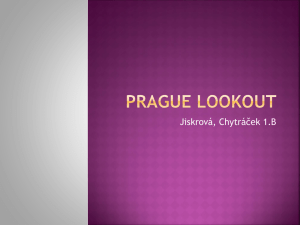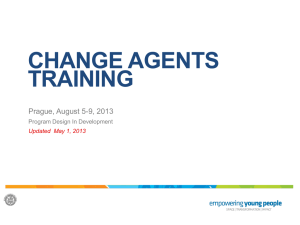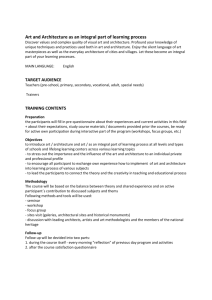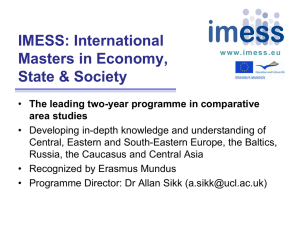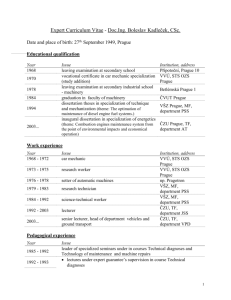What to Do in Prague
advertisement
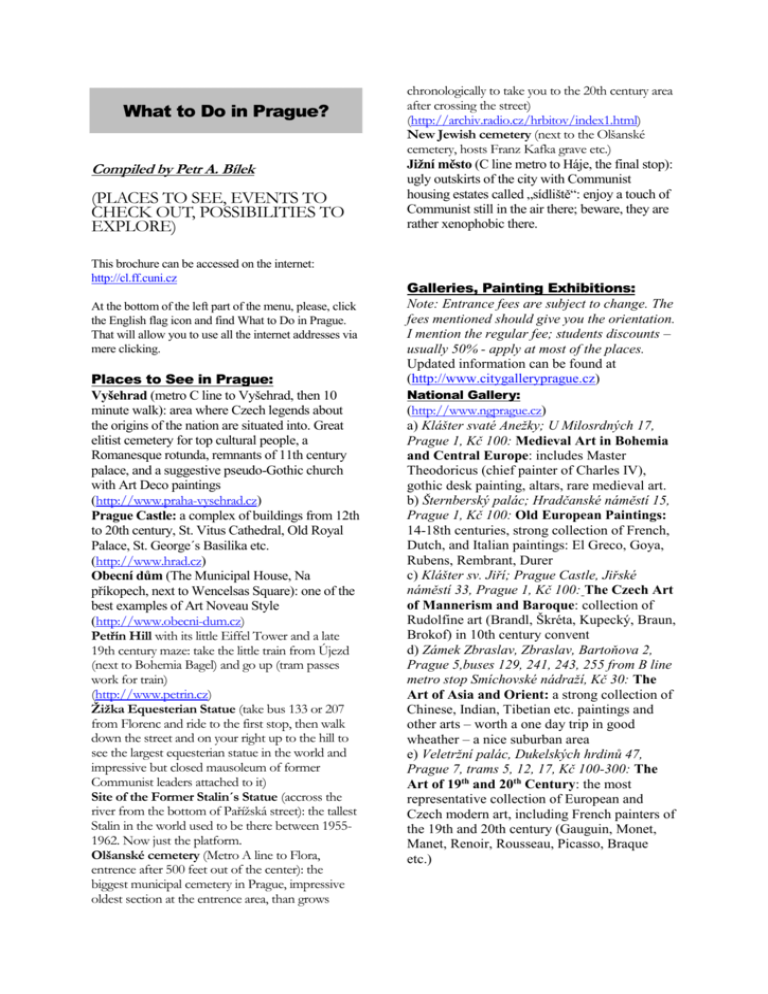
What to Do in Prague? Compiled by Petr A. Bílek (PLACES TO SEE, EVENTS TO CHECK OUT, POSSIBILITIES TO EXPLORE) This brochure can be accessed on the internet: http://cl.ff.cuni.cz At the bottom of the left part of the menu, please, click the English flag icon and find What to Do in Prague. That will allow you to use all the internet addresses via mere clicking. Places to See in Prague: Vyšehrad (metro C line to Vyšehrad, then 10 minute walk): area where Czech legends about the origins of the nation are situated into. Great elitist cemetery for top cultural people, a Romanesque rotunda, remnants of 11th century palace, and a suggestive pseudo-Gothic church with Art Deco paintings (http://www.praha-vysehrad.cz) Prague Castle: a complex of buildings from 12th to 20th century, St. Vitus Cathedral, Old Royal Palace, St. George´s Basilika etc. (http://www.hrad.cz) Obecní dům (The Municipal House, Na příkopech, next to Wencelsas Square): one of the best examples of Art Noveau Style (http://www.obecni-dum.cz) Petřín Hill with its little Eiffel Tower and a late 19th century maze: take the little train from Újezd (next to Bohemia Bagel) and go up (tram passes work for train) (http://www.petrin.cz) Žižka Equesterian Statue (take bus 133 or 207 from Florenc and ride to the first stop, then walk down the street and on your right up to the hill to see the largest equesterian statue in the world and impressive but closed mausoleum of former Communist leaders attached to it) Site of the Former Stalin´s Statue (accross the river from the bottom of Pařížská street): the tallest Stalin in the world used to be there between 19551962. Now just the platform. Olšanské cemetery (Metro A line to Flora, entrence after 500 feet out of the center): the biggest municipal cemetery in Prague, impressive oldest section at the entrence area, than grows chronologically to take you to the 20th century area after crossing the street) (http://archiv.radio.cz/hrbitov/index1.html) New Jewish cemetery (next to the Olšanské cemetery, hosts Franz Kafka grave etc.) Jižní město (C line metro to Háje, the final stop): ugly outskirts of the city with Communist housing estates called „sídliště“: enjoy a touch of Communist still in the air there; beware, they are rather xenophobic there. Galleries, Painting Exhibitions: Note: Entrance fees are subject to change. The fees mentioned should give you the orientation. I mention the regular fee; students discounts – usually 50% - apply at most of the places. Updated information can be found at (http://www.citygalleryprague.cz) National Gallery: (http://www.ngprague.cz) a) Klášter svaté Anežky; U Milosrdných 17, Prague 1, Kč 100: Medieval Art in Bohemia and Central Europe: includes Master Theodoricus (chief painter of Charles IV), gothic desk painting, altars, rare medieval art. b) Šternberský palác; Hradčanské náměstí 15, Prague 1, Kč 100: Old European Paintings: 14-18th centuries, strong collection of French, Dutch, and Italian paintings: El Greco, Goya, Rubens, Rembrant, Durer c) Klášter sv. Jiří; Prague Castle, Jiřské náměstí 33, Prague 1, Kč 100: The Czech Art of Mannerism and Baroque: collection of Rudolfine art (Brandl, Škréta, Kupecký, Braun, Brokof) in 10th century convent d) Zámek Zbraslav, Zbraslav, Bartoňova 2, Prague 5,buses 129, 241, 243, 255 from B line metro stop Smíchovské nádraží, Kč 30: The Art of Asia and Orient: a strong collection of Chinese, Indian, Tibetian etc. paintings and other arts – worth a one day trip in good wheather – a nice suburban area e) Veletržní palác, Dukelských hrdinů 47, Prague 7, trams 5, 12, 17, Kč 100-300: The Art of 19th and 20th Century: the most representative collection of European and Czech modern art, including French painters of the 19th and 20th century (Gauguin, Monet, Manet, Renoir, Rousseau, Picasso, Braque etc.) Other Galleries: The Czech Museum of Fine Arts (http://www.cmvu.cz) (Celetná 34, Prague 1, the Cubist House U Černé Matky Boží, Kč 35) Permanent Exhibition of Czech Cubism: Cubist exhibition: 4th and 5th floor, 1st-3rd floor: temporary exhibitions, mostly from the 1st half of 20th century City Gallery Prague (http://www.citygalleryprague.cz) (Galerie hl. m. Prahy, Dům u Zlatého prstenu, Týnská 6 - Ungelt, Prague 1, Kc 80) Czech Art of the 20th century: modern Czech painting of the best quality in a 13th century house: Art Nouveau, Symbolism, Civilism, Surrealism, Expressionism, Cubism, Informal, and Abstract Art at one place Alfons Mucha Museum (http://www.mucha.cz/) (Mucha Museum; Panská 7, Prague 1) legendary Art Noveau pantings, statues, posters, and photos of the most famous Czech artist of his time Kampa Museum (http://www.museumkampa.cz/) (Sovovy Mlýny, Prague 1, Kč 120) Meda Mladek´s collection of Czech Art of 20th century and temporary exhibitions in a reconstructed water-mill building from 19th century Museums: The National Museum (http://www.nm.cz) (Wenceslas Square 68, at the top, Kč 70): the biggest museum, built in 1818, mostly natural history: anthropology, zoology, paleontology. Also some bones of dinos from the jurrasic era. Lobkovický palác (Jiřská 3, Prague 1 – The Castle, Kč 40): the largest museum exhibit of Czech history, over 2000 ducements, pictures, artefacts that date since 4th century B.C. till 19th century Castle Trója (U Trójského zámku 1, Prague 7, bus 112 from C line metro stop Nádraží Holešovice, Kč 120): Czech art of 19th century in a charming Baroque mannor: Classicism, Biedermaier, Romanticism, Realism; as a whole, the tribute to Habsburg Monarchy; highly interesting garden with labyrinths; just next to Prague Zoo, which is worth seeing as well Marold’s Panorama (Výstaviště Praha, Prague 7, tram 17 from Staroměstská, Kč 20): Panoramatic painting (height 11 meters, lenght 95 meters) depecting a battle during the Hussite revolution; curiosity worth seeing; next to that is Lapidarium of The National Museum (Výstaviště 42, on your right after the entrance gate, Kč 20): a storage place of sculptures from 11th – 19th centuries: it hosts originals of works that were replaced by copies in the original areas (Charles Bridge etc.) The Prague Municipal Museum (http://www.muzeumprahy.cz) (Museum hlavního města Prahy; Na Poříčí 52, Prague 8 (next to Florenc metro stop; Kč 30): exposition documenting Prague settlement and development from the beginnings till the present + suggestive detailed model of Prague of 1830s, including the ghetto, Old Town, and Lesser Town The National Technical Museum (http://www.ntm.cz) (Kostelní 42, Prague 7, trams 1, 8, 25, 26, Kč 60): founded 1908, it hosts old cars, motorcycles, airplanes, filming tools and time measuring devices. If you are into that… The Museum of Decorative Arts (ulice 17. listopadu, next to A line metro stop Staroměstská, Kč 80): glass, ceramics, graphic art, photographs, furniture, textiles, fashion design, toys. The Mueller Villa (http://www.muzeumprahy.cz/www_mmp/txt/ B2.html) (Nad Hradním vodojemem 14, Prague 6, tram 18 to Ořechovka and then walk up the hill; the visit must be arranged – phone: 24312012, Kč 300): a fascinating work of Adolf Loos (1930) constructed according to the functionalist principles; rooms of different height stressing the vertical axis of all the house. A perfect attack on tradition, a must for architecture students. The Bílek’s Villa (http://www.citygalleryprague.cz/english/en_st ex/enstex.html) (Mickiewiczova 1, Prague 6, next to Hradčanská A line metro stop): a villa built by František Bílek, a Czech sculptor of the 1st half of 20th century, built as a Gesamtkunstwerk (unified complex) The Municipal House (http://www.obecni-dum.cz/) (nám. Republiky 5, Prague 1, at the end of Na příkopech, Kč 80): grandiose Art Nouveau building from 1912, decorated by A. Mucha, M. Aleš, J. V. Myslbek etc. A retail gallery specialized in Art Nouveau and Art Deco. The House of Wolfgang Amadeus Mozart (http://www.bertramka.cz) (Vila Bertramka; Mozartova 169, Prague 5 (Kc 50): exibition illustrating Mozart’s stays in Prague The Museum of Antonín Dvořák (http://www.nm.cz/mad/) (Museum Antonína Dvořáka; Ke Karlovu 20, Prague 2, Kc 30): displays and reconstructs life of a famous Czech composer, renowned in the U. S. for his Symphony from the New World. The Museum of Bedřich Smetana (http://www.nm.cz/mbs/) (Novotného lávka, Prague 1, next to the Charles Bridge, Kč 40): the biggest Czech composer of the national orientation: manuscripts, personal belongings, scores of his works you can activate by a laser baton. The Museum of American, Asian, and African Cultures (http://www.aconet.cz/npm) (Náprstkovo museum; Betlémské náměstí 1, Prague 1 (Kc 35): founded 1862, it hosts collections of native and ancient art of the above mentioned cultures The National Literary Monument and Czech Literature Archive (Strahovský klášter, Strahovské nádvoří 1, Prague 1 (above the Castle area): documentary exhibitions of oldest Czech manuscripts, prints, and rare books; together with the exhibition of Gothic and Baroque paintings and statues in a monastery which is remarkable by itself The Jewish Museum (http://www.jewishmuseum.cz) (Jáchymova 3, Prague 1): founded 1906, the museum has one of the most extensive collection of Judaic artifacts in the world (40 000 items, 100 000 volumes of books). The synagogues and cemetery belong to it: a) Maisel Synagogue: Rennaisance construction of a private synagogue of the mayor of the Jewish Town in 1592, rebuilt in the Baroque style after the fire in 1689, then rebuilt in Neo-Gothic style in 1905. Exhibit: History of Jews in Bohemia and Moravia. b) Spanish Synagogue: building in the Moorish style from 1868 on the site of the oldest Jewish prayer hall, The Old School Synagogue. Extensively reconstructed in 1998. Hosts the 2nd part of the Exhibit from Maisel Synagogue. c) Pinkas Synagogue: a construction from 1535. Now a Memorial to the Jews who fell victim to Nazi persecution: their names are recorded on walls. Exhibit: Children’s drawings from the Terezín ghetto. d) Klausen Synagogue: attached to the cemetery, the largest synagogue in the ghetto. Exhibit: Jewish Traditions and Customs. e) Old-New Synagogue: built in mid-13th century in the early Gothic style. One of the 3 Prague synagogues (also Vysoká and Jeruzalémská) which holds services. The Old Jewish Cemetery (Široká ulice 3, Prague 1): the last authentic part of the former Jewish ghetto. Founded in 1st half of 15th century, the oldest grave of the poet Avigdor Kar dates from 1439. Last burial 1787. More than 12 000 gravestones. The Monastery of the Prague Christ Child (The Church of Our Lady the Victorious, Karmelitská 9, next to Malostranské náměstí): 45 centimeters tall wax statue of Prague Jesus Infant from 1628, famous world wide. The Carmelite sisters dress the infant according to the seasons. The Loretto (Loretánské nám. 7, Prague 1, above the Castle, Kč 80): “Santa Casa”, a copy of the native house of Virgin Mary from 1626. Baroque era at the top: gold, diamond monstrances, carillon which plays each hour. The Tyrš Museum (Újezd 450, Prague 1, next to Lesser Town Area, K4 15): museum of physical education and sports, curious enough to be worth seeing The Pop Music Museum (Besední 3, Prague 1, Lesser Town area, Kč 50): history of rock music since 1956, guitars, radio receivers and historic tape recorders. Funny enough. The Prague Planetarium (http://www.planetarium.cz/) (Královská obora 233, next to the Výstaviště area): multimedia center for astronomy, special laser shows Štefánik’s Observatory (http://www.observatory.cz/) (Petřín 205, Prague 1, at the top of the Petřín Hill): views of heavenly bodies on clear nights Středočeské muzeum Roztoky (http://www.muzeum-roztoky.cz) (train from Dejvice train stop, 15 minutes): the 19th century Biedermaier (new burgeois) style, nice location, worth a Sunday trip Clubs and Bars with Live Music: Agharta Jazz Center (mostly contemporary jazz and blues, good quality). In: Krakovská 5, Prague 1 (next to Wenceslaw Square) http://www.arta.cz/aghaclub.htm Balbínova poetická hospůdka (modern folk music – a lot of Czech Bob Dylans). In: Balbínova 6, Prague 2 Baráčnická rychta (swing, folk music, experiments). In: Tržiště 23, Prague 1- Malá Strana Blues sklep (blues, latin music, jazz). In: Liliová 10, Prague 1 Jazz Club Železná (jazz, experimental and world music, sometimes great, sometimes boring, less formal atmosphere). In: Železná 16, Prague 1 (next to Old Town Square) http://www.jazzclub.cz/ Jazz club U staré paní (modern jazz of the best Czech quality). In: Michalská 9, Prague 1 – Old Town) http://www.ustarepani.cz/index_english.htm Lucerna Music Bar (jazz, blues, rock sometimes concerts, sometimes recorded music; from Elvis Presley to Led Zeppelin). In: Vodičkova 36, Prague 1 http://www.musicbar.cz/ Malostranská beseda (live blues and rock music, Czech bands, pleasant atmosphere, more locals than tourists). In: Malostranské náměstí 21, Prague 1 http://www.mb.muzikus.cz/ Music Club U malého Glena (Little Glen´s) (mixed up stuff: mostly modern jazz): In: Karmelitská 23, Prague 1 – Malá Strana) http://www.malyglen.cz/ Palác Akropolis (rock, underground, and world music, depends on the program quite a lot). In: Kubelíkova 27, Prague 3 http://www.palacakropolis.cz/ Radost FX (dance parties, house, soul, rather snobish but stylish) In: Bělehradská 120, Prague 2 http://www.radostfx.cz/ Reduta (traditional and modern jazz, good but rather fancy and snobish). In: Národní 20, Prague 1) Red Hot&Blues (contemporary jazz and blues, also famous for great mexican food) In: Jakubská 12, Prague 1 Rock Café (recorded or live music, parties, usually great though little yuppie atmosphere). In: Národní 20, Prague 1 http://www.rockcafe.cz/ Roxy (DJ parties – one of the most popular places for Czech teenagers). In: Dlouhá 23, Prague 1 http://www.roxy.cz/ Unglet jazz´n´blues Club (contemporary blues). In: Týnská ulička, Prague 1 – Old Town http://www.jazzblues.cz Theaters with no or little need of Czech language: (Warning: due to the advantage of no need of Czech, these programs are intended for tourists and that may tell quite a lot about their quality!) Laterna Magica (visual art theater performances that used to be legendary in 1960s; it is 2000s now...) In: Národní 4, Prague 1 http://www.laterna.cz Národní divadlo marionet (Mozart´s Don Giovanni in a puppet theater version; curious...) In: Žatecká 1, Prague 1 http://www.nationalmarionettetheatre.com/ Yellow Submarine („synthesis“ of paintings, puppets, and black theater based on The Beatles movie...) In: Divadlo v Celetné; Celetná 13, Prague 1 Orfeo ed Euridice (the same type of performace in the same theater as the above one) Black Theater (famous but too obvious to whom it is intended) In: Rytířská 31, Prague 1 Black Theater of Jiří Srnec (the same type as the above one, this one owned by the inventor of some black theater tricks). In: Lucerna Hall, Štěpánská 61, Prague 1 http://www.blacktheatresrnec.cz Ta Fantastika (experimental type of black theater with live music together; some people love it but same hate it). In: Karlova 8, Prague 1 Bookstores and Second Hand Bookstores with Books in English: Anagram Bookstore (Týn 4, Ungelt Courtyard, next to the Old Town Square, just past the Gothic Týn Church – the tall one): probably the best offer, nice and pleasant shop assistants, willing to order books they do not have at the moment The Globe (Pštrossova st., Prague 1, around the Tesco area): a wide rank of books, however not quite willing to order those you want U knihomola (Mánesova ulice, Prague 2): cozy, small, pleasant, with a little café Big Ben Bookshop (Malá Štupartská 5, Prague 1, next to St. Jacob´s church, close to Old Town Square): (standard one) Fišer Bookstore at the Philosophical Faculty (náměstí Jana Palacha 2, Prague 1, next to Staroměstská metro station): standard equipment Knihkupectví Seidl (Štěpánská ulice 26, Prague 1, next to Wenceslas Square,when going up, in the middle of it turn right): excellent bookstore but English section is rather mediocre Knihkupectví Franze Kafky (Old Town Square 12, Prague 1): rather turisty, of course Palác Luxor (Wenceslas Square, upper part, on your left when going up): the biggest megastore in Central Europe with all the pros and contras these shops have Knihkupectví Kanzelsberger (Wenceslas Square 4, Prague 1, at the bottom of the square, on your right when looking up to St. Wenceslas statue): a typical megastore, English section is quite standard, but they have lots of books on painting, on Prague, etc. Knihkupectví Krakatit (Jungmannova 14, Prague 1): comics, sci-fi, horrors, military Knihkupectví Na Můstku (Na příkopě 3, Prague 1, at the bottom of Wenceslas Square): Tolkien, Harry Potter, tourist guides, Pragensia, simply books that sell Restaurants, pubs etc.: Al Capone´s (Bartolomějská 3, Prague 1): recommended when you are about to have a coctail Ambiente Restaurant (Mánesova 59, Prague 2): rather fancy place with great food; good when your parents are in town to treat you with a dinner Blatnička (Michalská 8, Prague 1): a famous place of 1980s, nice underground area and good local Moravian wine, usually still crowded at night Cantina (Újezd 38, Prague 1, under the Petřín Hill): excellent Mexican food prepared by a chef from Prague Chaos (Masarykovo nábřeží 26, Prague 1, 500 feet behind the National Theater when going as if out of Prague): rather fancy but great style and excellent food, empty for lunches, packed for dinners; definitly worth the trip Country Life (Melantrichova 15, Prague 1, in between Old Town Square and Wenceslas Square): a nice vegetarian place with a self-serve systém Góvinda (Na Hrázi 5, Prague 8, Palmovka B line metro stop): a veggie, Hare Krsna Indian place with a style; limited choice of food each day Hostinec U Sádlů (Klimentská 2, Prague 1, in the Kotva area): a good place with large portions of local food; be aware that it might attack your diet systém Indická restaurace (Štěpánská 61, Prague 1, next to Wenceslas Square): good though rather expensive Indian food Jáma (V J8mě 7, Prague 1, parallel street to Wenceslas Square): if you want to see a crowd of yuppies… Jelínkova plzeňská pivnice (Charvátova 1, Prague 1, between Tesco and Jungmannova st.): excellent Pilsner beer, no food, always crowded but worth tasting such a beer Klub architektů (Betlémské náměstí 169, Prague 1, in between Tesco and Old Town area): a good place for decent dinners Kojak’s restaurant (Anny Letenské 16, Praha 2, above Wenceslas Square): great Mexican and American food, very decent prices for lunch specials, standard prices for dinners; local favorite in that area, that is why crowded at nights Kozička (Kozí 1, Prague 1, behind the Old Town Square when going to Náměstí Republiky): a big place that serves good food and beer also after midnight Na Zvonařce (Šafaříkova 1, Prague 2, at the I. P. Pavlova C line metro stop): a nice local place Olympos (Kubelíkova 9, Prague 3, in the Jiřího z Poděbrad A line metro stop): quite authentic Greek food and Retsina Greek local wine Peklo (Strahovské nádvoří 132, Prague 1, above the Castle): the other great and fancy place for the occasion of your parents stay in town; beware, this one is truly expensive Pivnice U Pivrnce (Maislova 3, Prague 1, at the former Jewish ghetto area): a local place with good but unhealthy food for a decent price and nasty paintings all over the walls Pizzeria Kmotra (V Jirchářích 12, Prague 1): a good place if you feel like having a pizza Ponte (Anglická 15, Prague 2, at the I. P. Pavlova C line metro stop area): great food in the French style, rather expensive but worth it Potrefená husa (Vinohradská 104, Prague 3, next to Flora A line metro stop): an American style place for those home sick; great food but crowded at nights Pravěk (Budečská 6, Prague 2, next to Náměstí Míru A line metro stop): a small place stylized into the era of mamoths; big portions of tasty though rather unhealthy food in the way the chef imagines the old days; eating it each day might cause you some troubles První novoměstský restaurační pivovar (Vodičkova 20, Prague 1, 600 feet from Wenceslas Square): they have their own yeast beer and perfect rooms 1-4 levels underground; groups of turists brought in each minute Rudolfinum (Křižovnická, next to the faculty building at the point of the tram isle of Staroměstská): great local pub, however: packed and full of smoke in evenings Rudý baron (Korunní 23, Prague 2, parallel street to Vinohradská): a great place for half pound of beef Řecká taverna (Revoluční 16, Prague 1, in the Kotva area): good Greek food (gyros etc.) in the center of Prague Tequila Sunrise (Štupartská 6, Prague 1, behind the Týn Church at the Old Town Square): the name says it all U Bubeníčků (Myslíkova 8, Prague 2, in the Tesco area): a good local place for a beer or two U Fleků (Křemencova 9-11, Prague 1, in the Tesco area): a pub that dates back to 1499, with its own brewery and cabaret program; packed with turists coming with buses to have one beer at the place; famous but only for strong characters who want to see a place based on making money idea only U Houdků (Bořivojova 110, Prague 3, one tram stop next to Hlavní nádraží and then climb the hill): a typical local place with good food and beer for a decent price; they have a garden open spring to fall; because it is truly local, they speak Czech only U Kalicha – U Švejka (Na Bojišti 12-14, Prague 2, at the I. P. Pavlova C line metro stop): if you want to see turism at the nastiest level: waiters dressed in the style of Hapsburg empire, pictures of the Czech literary icon Švejk all around; expensive and not worth the price at all, only to witness how low you can get U kapra (Žatecká 7, Prague 1, next to Staroměstská A line metro stop): a decent place at the center with an open garden; small portions of an O. K. food U kata (U Radnice 6, Prague 1, next to the Old Town Square): one of the last local places in the center, good beer for a good price at the center) U malého Glena (At the Little Glen’s) (Karmelitská 23, Prague 1, Lesser Town Area, next to the U.S. embassy): if you want to see some local Americans… U Medvídků (Na Perštýně 7, Prague 1, just next to Tesco): if you are in the area and you do not want to travel anywhere; good beer but beware: it is the Czech Budweiser and having 5 and more causes headache the next day; food is just mediocre here U milosrdných (U milosrdných 12, Prague 1, behind the Spanish synagogue): the other relict of the local pub at the center, good Gambrinus beer, standard local food U Staropramene (Nádražní 102, Prague 5 – Smíchov, metro stop B line Anděl): a large place of the Staropramen brewery, good for both beer and food U vystřelenýho voka (U božích bojovníků 3, Prague 3): a famous pub in one of the dark Žižkov´s corners, good beer, nice people U zlatého tygra (Husova 17, Prague 1, on your way from the Old Town area to the Tesco): the best beer in town, do not go as a group, they are rather sceptical about the turists, opens at 15.00, full everyday after 17.00): Vinárna U Jiříka (Vinohradská 62, Prague 2, at the Jiřího z Poděbrad A line metro stop): a hidden place as if from 1980s, rather expensive but excellent food Vínečko 33 (Budečská 40, Prague 2, next to Vinohradská st.): a small and crowded place with local Moravian wine that tastes great but causes headeaches the next day Zahrada v opeře (at the top of the Wencleslas Square, after crossing the highway)at the Radio Free Europe building) – the best protected pubs nowadays: you have to make your way through the soldiers; rather fancy but perfect design and food Cafés that have some style: Café Archa (Na Poříčí 26, Prague 1): a big, 1930s retro style café with great mosaics that cover walls Café Černá labuť (Na Poříčí 25, Prague 1): just opposite the Café Archa, a silent place with gallery in the 8th floor of a bookstore building, wonderful view, but don´t expect any touristic panorama Café Imperial (Na Poříčí 15, Prague 1): an old-fashioned place, always well supplied with fresh donuts, live jazz music almost every night Café Konvikt (Bartolomějská 11, Prague 1): rather ecclectic café with a nice room at the lowest level Café Louvre (Národní třída 20, Prague 1): large stylish café founded in 1902, opens daily at 8 AM to serve wonderful breakfasts Café Montmartre (Řetězová 7, Prague 1): a small place with 1920s retro style, rather noisy at night Café No. 14 (Opatovická 14, Prague 1): very nice although rather smoky, silent enough to read or work Café Rybka (Opatovická 7, Prague 1): a small corner café with bookstore Dobrá trafika (Korunní 42, Prague 2 and Újezd 37, Prague 1): beware, café is hidden behind a newspaper and cigar store, very silent place during day, sometimes crowded at nights Ebel Coffee House (Tyn 2, Prague 1, near the Old Town Square): possibly the best coffee in Prague, fresh roasted arabicas in the silent court of Ungelt Kaaba Café (Mánesova st., Prague 2): a small but perfect 1970s Communist plastic style café with stylish music Kavárna V sedmém nebi (Zborovská 68, Prague 5- Malá Strana): a cosy place, good choice of wines Malostranská kavárna (Malostranské nám 5/28, Prague 1): one of the places that have been serving coffee for a century, decently reconstructed, but of course rather touristy these days Marathon (Černá 9, Prague 1): a very cheap café in the building of Evangelic Faculty full of theology students playing chess Medůza (Belgická 17, Prague 2): a busy café in one of the silent streets of Vinohrady, nice people, great food Café Slavia (Smetanovo nábřeží 2, Prague 1, across the National Theater building): probably the most famous one that survived; enjoy the architecture based on elevating a café goer above the level of the street Velryba (Opatovická 24, Prague 1, in the Tesco area): a favorite place of Czech literati and newspaper people, great food but always crowded and noisy Useful websites: Cdrail – websites of Czech railways, time-tables, information about price reduction etc. (http://www.cdrail.cz) Czech Republic – one of the many, this one is quite useful (http://www.czechsite.com/) Express– tips for travelling and activities (http://www.a-e-express.com) Gurman - a gurmet guide to the best eateries in Prague (http://www.gurman.cz) Heart of Europe – a cattalogue of galleries, museums, trade fairs etc., only basic information (http://www.heartofeurope.com) Maps – city plans and maps for you not to lose the way (http://www.mapy.cz) National Library – if you need any books you can order them on-line after registration (http://www.nkp.cz) Prague – all you want to know about life in Prague, funny pages for all Prague-lovers (http://prague.tv/) Prague – a detailed, useful guide to places with comprehensive information (http://www.pragueexperience.com/sightseeing/si ghtseeing.asp) Prague Tourist Information Service: official Prague townhall service organization: essencial but complex information (http://www.prague-info.cz) Prague Post – weekly newspaper published in Prague, nicely done, well informed and entertaining – don´t miss their selection of best pubs and restaurants. You can find here all essential information you need. (http://www.praguepost.com) Public Transportation – all information about public transport in Prague (http://www.dp-praha.cz) Telecom – oficcial phone list of Czech Republic (http://www.telecom.cz) Ticketpro – if you want to buy tickets on-line, click here to be provided by tickets to almost all theatre performances, concerts and musicals youˇve chosen (http://www.ticketpro.cz) Travel Timetables – a search engine for major destinations (http://www.jizdnirady.cz) Visit Czechia – official website of the Czech Tourist Authority, very practical, well organized, shouldn´t be missed (http://www.visitczechia.cz) Trips outside of Prague: Some websites with substantial information: Czech Castles – pictures and depictions of the major castles and chateaus (http://www.czechcastles.com/index.html) Sightseeing in Prague and around – some essential sites described (http://www.sitesatlas.com/Europe/CzechRepu blic/Prague.htm#sights) Central Bohemia: Kutná Hora (discrict town, 1 hour by bus) Kutná Hora is an ancient mining town renowned for the white Prague groschen were minted here. If you want to get the feeling, in Hrádek area you´ll be given long coats and lanterns there and you can visit an original medieval mine. The landmark of the town is the monumental Gothic Church of Saint Barbora with valuable paintings and decoration. Compare this sample of late Gothic with an earlier cathedral of St. James at the center of town. (http://www.kh.cz/seznam/seznam.php?l=en& node=0) Last but not least, an ossuary in Sedlec – in about ten minutes ride from Kutna Hora – should be mentioned: bones out of more then 40 000 people piled to make the decoration of a church. Morbit, touchy but worth experiencing. (http://www.kh.cz/listy/info.php?id=17&l=en) Karlštejn (Beroun district, by train, about 40 minutes): The castle was founded in the 14th century by Charles IV as a stronghold intended to house the imperial coronation jewels. The walls of the Chapel of the Holy Rood are covered with panel paintings of male and female saints by one of the most famous Czech Gothic painters known as Master Theodoric. (However, if you want to see the chapel you should make a reservation). (http://www.hradkarlstejn.cz/) Konopiště (train or bus to Benešov u Prahy, then a 20 minute walk): a Romanticized chateau owned by the Habsburg throne successor František Ferdinand d´Este. Impressive collection of hunting trophies and other 19th century icons of the life of nobles. (http://www.zamek-konopiste.cz) Český Šternberk (Benešov district, by bus or train, about 1 hour): A summer resort with a castle overlooking the river Sázava, founded in 13th century. The castle contains in particular a collection of engravings of the 17 th century. (http://www.hradceskysternberk.cz) Sázava nad Sázavou - the remains of a benedictine monastry from 1009 and the centre of the Slavonic culture - is not far from there. However, you need either the car or lots of patience and planning to use local bus transportation. (http://uj.euweb.cz/index.php?page=/saklaster. php) Nelahozeves (30 km from Prague, 20 minutes by train): a renaissance chateau owned by Lobkowitz noble family, built in the end of 16th century on the rock above the banks of Vltava river. Worth to see especially for valuable collection of old paintings including Rubens or Brueghel. You can also visit a birthplace of famous Czech composer Antonín Dvořák and last but not least – you shoudn´t forget to taste some of the excellent wines from Lobkowitz wine cellars. If you have some time left than try to take a walk to the nearby baroque castle Veltrusy that has beautiful wide gardens with peacocks walking freely in it. (http://www.bohemianet.com/stredni_cechy/ne lahozeves/nelahozeves_en.htm) (http://www.stezka.cz/lokality/melnik/veltrusy. htm) Křivoklát (Český kras area, 1,5 hour train ride via Beroun): a royal hunting castle hidden in a deep forest, impressive and less crowded that Karštejn (http://www.krivoklat.cz/webs/english/krivokl at/ea2.htm) Žebrák, Točník, Krakovec (about an hour by bus from Prague): Three castles built in the 14th century, nice examples of well preserved middle age architecture. They are not too far from each other, so you can visit them all in one day if you go by car or by bike. (http://www.krivoklat.cz/webs/english/tocnik/e h3.htm) Southern Bohemia: Český Krumlov (southern Bohemia, 3 hour ride by bus): a gorgeously well preserved Renaissance town with a Baroque Castle. Picturesque, turist friendly. Worth a weekend trip. (http://www.ckrumlov.cz) Holašovice: a village-preserve, 18th century Baroque village with impressive gates and farmer houses, sweet on the edge of a kitsch (http://www.budnet.cz) Hluboká: a nightmare for a historian looking for authenticity, a feats for kids and fairy tale lovers: a pseudo historic, 19th century Romanticized castle supposed to impress via its nobility. So kitschy that it makes it worth seeing. (http://www.hluboka.info/en/index.xml) Jindřichův Hradec: a town full of nice mixture of Renaissance and Baroque styles, impressive castle and church. (http://www.jh.cz/) Nothern Bohemia: Bezděz (1 and ½ hour bus ride to Doksy, then a bus to Bezděz, and ½ climb to the top of the hill). Ruins of the medieval castle, great view of the area. Romantic, impressive, exhausting. Worth the trip. (http://www.clnet.cz/region/historie/hradyzamky/bezdez/) Říp (1 hour bus ride to Roudnice nad Labem, then the other bus to Krabčice, then walking up to the hill). Mystical breast like hill; according to the legend, Father Czech took his tribe to the hill and made the decision to live in the area for ever. (http://www.hrady-zamky.cz/rotunda-rip/) Český ráj (1 hour bus ride to Turnov, then 1 hour walking or using local buses): impressive rocky mountain area ready for climbing, trecking or sightseeing; picturesque, impressive but requires a one day trip at least. (http://www.ceskyraj.cz/priroda/) If you have time, visit local castles – romantic Sychrov (http://www.zamek-sychrov.cz/) , gothic castle Kost (http://fmv.vse.cz/cz/castles/kost.htm), castle Hrubý Rohozec (http://www.hrubyrohozec.cz/rohozec/ramindex.htm) or Valdštejn castle (http://www.turnov.cz/en/valdstjn.htm). Liberec (1 hour bus ride) – quite an impresive Suddeten town that had its peak before the WWII but now grows again: zoo, galleries, cafes; slow pace of life as a contrast to Prague (http://www.liberec.cz/) Eastern Bohemia: Litomyšl (3 hour bus ride from Prague): a well preserved Renaissance town with a chateau gardens, and amphitheater (http://www.litomysl.cz) Pardubice (2 hour bus or train ride): a living town with beautiful renaissance castle and well preserved historical town centre (http://www.mesto-pardubice.cz/) (http://www.vcm.cz/) If you go by car – visit nearby Zoo in Dvůr Králové with the largest collection of African animals in Europe. If you go there in summer, take a Safari-bus ride among free living hoofed animals. (http://www.zoodk.cz) Western Bohemia: Karlovy Vary - Karlsbad (2 hour bus ride from Prague): famous spa resort founded in 14th century, visited by Casanova, Mozart or Freud. Very quiet place hidden in the green valley of Teplá river with beautiful colonades, where you can have your own drinking cure tasting one of 12 healing springs or local herbal liqueur called Becherovka. (http://www.karlovyvary.cz) If you decide to spend there more than one day, visit nearby spas of Mariánské lázně (Marienbad) and Františkovy lázně (Franzensbad). (http://www.marianskelazne.cz/) (http://www.franzensbad.as/) Plzeň – Pilsen (1 hour bus or train ride from Prague): city founded in 13th century with beautiful city center is worth visiting especially for its world-famous brewery. Try the Brewery Museum and than have a rest with a well chilled glass of Pilsen. (http://info.plzen-city.cz) (http://www.beerworld.cz/) Southern Moravia (better to rent a car, though some trains and buses can get you there): Brno (3 hour bus or train ride): a second largest city in Czech Republic with friendly atmosphere, seems to be ideal basic camp for exploring Southern Moravia – you can spend several nights either in Brno or in nearby camps. Brno is a must-see for lovers of modern architecture: visit at least a functionalist Tugendhat Villa built by Mies van der Rohe. (http://www.brno.cz/index.php?lan=en) (http://www.tugendhat-villa.cz) Mikulov (3 hour bus ride to Brno, than one hour bus ride to Mikulov): the town lies in a wine-making region near the Czech-Austrian borders, some 100 km from Vienna. Visit local baroque chateau and some of numberless wine-cellars or take one of the wine trails through small wine growing villages. (http://www.mikulov.cz) (http://www.pragueviennagreenways.org/winet rails.html) Lednice and Valtice Complex: „a cultural complex“ of well preserved parks, biking routes and landscape designed to be a „Garden of Europe“, plus Romanticism style impresive chateau, next to it a minaret (http://fmv.vse.cz/cz/cz/lednice.htm) Slavonice (3 hour bus ride from Prague): forgotten Renaissance little town with probably best preserved complex of houses from the 16th and 17th century (http://www.slavonice-mesto.cz/eng/) Telč (3 hour bus ride from Prague): quite an impressive Reanaissance town, with a chateau and gorgeous main square (http://www.telc-etc.cz) Žďár nad Sázavou: Pilgrimage Church of Saint John: out of the town, on Zelená Hora, there is quite an impressive 18th century Baroque church designed by Johann Blasius Santini, original and brilliant in terms of technique and hidden symbolism (http://www.zdarns.cz/) Moravský Krumlov: the castle hosts the exhibition of Alfons Mucha´s patriotic large scale paintings, quite impressive in its size as well as nationalistic mythologization (http://www.mkrumlov.cz) Central Moravia: Olomouc (3 hour bus ride from Prague): the second largest urban monument reserve after Prague, great Baroque appeal of the city, including the Holy Trinity Column that made it into the UNESCO List of the World Cultural Heritige (http://www.olomoucko.cz) Kroměříž (4 hour bus ride from Prague): definitely worth seeing. Beautiful town with baroque archiepiscopal chateau and splendid renaisance and baroque gardens, inscripted into UNESCO World Heritage List. Don´t forget to visit archbishop´s wine cellars and buy a bottle of mass wine. (http://www.azz.cz/) Rožnov pod Radhoštěm: a „skanzen“ museum in the open air, hosting original country houses and folk Moravian architecture and arts, lots of „slivovice“ (a local liquer) around.
